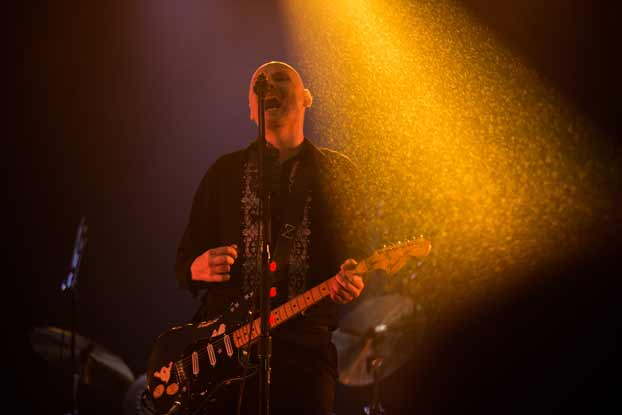The Almighty Riff: Suggestions for Stimulating Musical Creativity

The following is a classic column from the pages of Guitar World.
Every great rock song has a great riff, be it a single-note melody or a chordal-based sequence, and that's probably what makes it a great song. Like a great frontman, a really good rock riff should have a hypnotic, star quality.
A great riff can take you over; you might find yourself playing it repeatedly for 10 minutes. There's something about it that makes you want to indulge in it. "Siva," from our first album, Gish, had one of those riffs that let me know immediately that I had a song, even though I had yet to work out all the parts.
That riff sounded like my band-it had instant identity-and it got my blood going right away. There was something about it that was so distinctive that it made a lot of other songs I'd written seem wimpy and weak by comparison.
Since then, I've always tried to find that weird marriage of a great riff and a song that fits with the riff. The "Siva" riff crystallized everything I was trying to do with the band. It had power and immediacy, and the song seemed to write itself around the riff.
When I wrote "Siva," I was working in a record shop, and I used to bring an acoustic guitar in with me to work. When no one was in the store, I'd just sit behind the counter and play. So, this was a riff that I wrote on acoustic, keeping in mind that I would transfer it to loud, heavily distorted guitar later. It was buzzin' in my head! Almost a reverse-case scenario occurred with the song "Today," from Siamese Dream. I had all of the chords and the melody, but no opening hook.
At that point, we just started the song with the verse chord progression [Eb-Bb-Ab], which in and of itself is catchy because of the inherent melody. I knew I had to come up with some sort of opening riff. Then, out of the blue, I heard the opening lick note-for-note in my head.
That's the state of mind I've trained myself to be in: I'm always looking for the guitar hook. When I added the opening riff, it completely changed the character of the song. Suddenly, I had a song that was starting out quiet and then got very loud. I could start to hear the shifts in the song as it progressed. I knew that I was going to bring that riff back in for emphasis, and I knew where I could do that.
In the realm of songwriting, you really have to mine the territory and search for good riffs. Both of these examples show that heaviness is not the only thing that makes for a good riff; of far greater importance is the context within which the riff is used. To me, the best rock riff writer right now is Diamond Darrell of Pantera.
At the other end of the sonic spectrum is the Edge from U2, who plays completely stylized parts that propel the songs. When I find that I can't seem to escape the shackles of what's already been done, or if I feel that I'm locked into a "traditional" way of thinking, I turn to rhythm guitar.
Ultimately, that seems to open up infinite possibilities-far more than just sitting around noodling. Another option is to play the bass, which seems to push my writing in a more rhythmic direction. "I Am One," from Gish, is an example of a song that has a pretty decent guitar riff, but a killer bass riff to support it.
Another way to inspire yourself to come up with good riffs is to use effects, and to try different tunings. The great thing about effects is that they change the way you hear the guitar, thereby changing the way you react to the guitar. The most mundane licks can turn into something completely different with the right effect. Phasers, flangers, fuzzboxes and especially delay units will all inspire new ideas. David Gilmour has done some incredible things with delays in Pink Floyd.
For the song "Starla," from Pisces Iscariot, I had a riff which didn't really do much for me. Then, I ran it through a fuzz (which gave it a drone-y sound and added some different harmonics), and panned it back and forth in time with the song. Soon, I started to hear an orchestration for the song. The effects inspired the arrangement, even though I didn't end up using the original effects on the final version of the tune.
Different tunings, like effects, will make the guitar seem like a whole new instrument. James wrote "Mayonnaise" [Siamese Dream], after just screwing around with tunings until he came up with something he liked (Eb, Bb, Bb(same octave), Gb, Bb, D). Using this tuning, he stumbled across an Ebsus2/Cm/Ab chord progression, which ultimately shaped the song. For the record we're working on now, we're tuned down a half step for everything.
This alone is altering the way we play and how our songs will sound. You must force yourself away from what you know into territory that is often uncomfortable, and occasionally disappointing. There is as much potential in songwriting as you are willing to mine, but it doesn't always come easily. You've got to work at it. I wish you the luck of the Metal Gods.
Get The Pick Newsletter
All the latest guitar news, interviews, lessons, reviews, deals and more, direct to your inbox!












